Introduction
Artificial insemination (AI) has found widespread use since its commercial development in the 1950s (Vishwanah, Reference Vishwanah2003). Dairy farmers world-wide appreciate the rapid genetic improvement in production and conformation traits resulting from using semen of progeny tested bulls. Furthermore, the risk of venereal disease transmission has been eliminated, the incidence of dystocia has been reduced and early breeding of virgin heifers or post-partum cows and accidents during mating are avoided. Moreover, dry cow management can be better controlled due to accurate drying off and calving dates. Breeding management has become more flexible by using semen of many bulls of the same or different breeds and, last but not least, the safety of farm personnel is ensured (Esslemont et al., Reference Esslemont, Bailie and Cooper1985; Barth, Reference Barth, Braun and Youngquist1993; Ensminger, Reference Ensminger1993; Peters and Ball, Reference Peters and Ball1995; Vishwanah, Reference Vishwanah2003).
In countries of Northern Europe, Israel and Japan, dairy farmers use AI almost exclusively (80 to 90%) as the service method for breeding cattle (Peters and Ball, Reference Peters and Ball1995). Despite the recognised benefits of using AI, however, a large number of dairy farmers in other parts of the world still use natural service (NS) to breed all or part of their cattle herds. In the US, AI is used exclusively by around 45% of dairy farmers (United States Department of Agriculture, 2002).
In Greece, around 47% of dairy farmers use AI exclusively to breed their cattle, 31% of them use both AI and NS, and 22% use NS only (Valergakis, Reference Valergakis2000). Previously, AI was carried out by state employed technicians but now the government policy is to privatise the industry and, since the commercial AI sector is still not fully developed, the on-going trend, especially on bigger farms, is towards more frequent use of NS bulls or do-it-yourself AI (DIY-AI). Compared with using the state's AI service, this latter method is profitable for herds with more than 32 cows. In a typical 80-cow herd, annual savings exceed €700 ($885) (Valergakis et al., Reference Valergakis, Banos, Arsenos and Zioganas2004).
One of the main arguments for using of NS is the higher perceived AI costs compared with those of keeping herd bulls and additional costs resulting from extended calving intervals (ECI) because of poor heat detection and conception rates when using AI (Risco, Reference Risco and Chenoweth2000; Valergakis, Reference Valergakis2000; Cassell et al., Reference Cassell, Jobst, McGilliard and Pearson2002; Overton, Reference Overton2005). Dairy farmers in Greece consistently under-estimate, or even ignore, the costs associated with keeping an NS bull while, at the same time, they face the financial consequences of ECI. Most of the times, however, the latter is due to reasons irrelevant to AI, such as inadequate nutrition and poor health management (Valergakis, Reference Valergakis2000; Valergakis et al., Reference Valergakis, Banos, Arsenos and Zioganas2004).
Direct comparisons of AI and NS costs are rather rare in the literature (Hillers et al., Reference Hillers, Thonney and Gaskins1982; Overton, Reference Overton2005). These comparisons, in order to be accurate and acceptable to dairy farmers, must reflect real farm conditions, practices and economics. For example, the recently published research by Overton (Reference Overton2005), based on a 1000-cow dairy unit using rotational groups of NS bulls, found little or no application in Greece where all dairy farms are smaller in size and most of the times only one bull is kept (Valergakis, Reference Valergakis2000). The same is true for published annual costs of keeping herd bulls in the UK and the US (Esslemont et al., Reference Esslemont, Bailie and Cooper1985; Johnston et al., Reference Johnston, Sendelbach and Howard1987).
One commonly discussed issue is whether the breeding performance of the two service methods (AI and NS) is equal. Although there is research documenting equal or superior performance of AI (Williamson et al., Reference Williamson, Morris and Anderson1978; Shaw and Dobson, Reference Shaw and Dobson1996; Niles and Risco, Reference Niles and Risco2002; Overton and Sischo, Reference Overton and Sischo2005), this is not readily accepted by most dairy farmers who, more often than not, claim better performance of NS bulls. Other research has reported an advantage of NS concerning the length of calving interval, thereby supporting the prevailing farmer opinion (Valergakis, Reference Valergakis2000; Smith et al., Reference Smith, Ely, Gilson and Graves2003; Zwald, Reference Zwald2003; De Vries et al., Reference De Vries, Steenholdt and Risco2005). Consequently, the cost of any extra ‘days-open’ must be included in the economic comparison of the two service methods.
Many authors have addressed the issue of the cost of ‘days-open’ and although some find it nonexistent (Arbel et al., Reference Arbel, Bigun, Ezra, Sturman and Hojman2001) or small (Holmann et al., Reference Holmann, Shumway, Blake, Schwart and Sudweeks1984; Schmidt, Reference Schmidt1989), most conclude that it can be significant (Britt, Reference Britt1985; Williams et al., Reference Williams, Oltenacu, Bratton and Milligan1987; Barth, Reference Barth, Braun and Youngquist1993; Plaizier et al., Reference Plaizier, King, Dekkers and Lissemore1997; Reference French and NebelFrench and Nebel, 2003a; González-Recio et al., Reference González-Recio, Pérez-Cabal and Alenda2004). Specific economic conditions in each country or time period have a great influence on cost of ‘days-open’ and this should be assessed every time a study comparing AI and NS costs is conducted.
The objective of this study was to estimate, compare and analyse the costs associated with breeding cattle by DIY-AI and NS, and identify the factors that influence them, under typical dairy farming conditions in Greece.
Material and methods
Data
A simulation study was designed based on data collected from 120 dairy cattle farms (Valergakis, Reference Valergakis2000) located in Northern Greece, the main dairy area of the country. The average herd size was 87 cows (Holsteins, range 40 – 285 cows) and the average milk production was 6443 kg milk per cow per year (range 4000 to 9300 kg). Farm characteristics and performance, when they were classified according to service method are presented in Table 1. Calculations, based on actual farmers' practices, included: (a) direct AI and NS costs and (b) costs associated with extended calving intervals due to AI.
Table 1 Farm characteristics and performance when classified according to service method
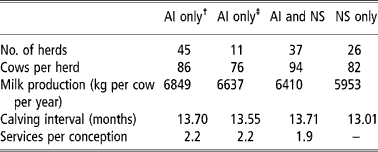
† Semen from proven sires only.
‡ Semen from pedigree selected sires (Greek Ministry of Agriculture).
Calculation of natural service costs
Bulls used for natural service were either born on the farms that subsequently used them or were purchased from ‘breeder’ farms at a very young age (approx. 6 months old). They were usually sons of proven Holstein bulls. The selection criteria were mainly their dam's milk production and their sire's genetic merit. It should be noted here that only few of the ‘homebred’ bulls were actually homebred. Most were born to pregnant heifers imported from various European countries. Bulls were used for breeding when they were 18 months old and had reached a body weight of around 550 kg. Smaller farms ( < 80 cows) kept just one sexually active bull, whereas bigger farms kept two or more. Overall, no bull sired more than 80 calves per year on any of the sample farms and this was considered as the typical performance of NS bulls when AI and NS were compared. Young bulls were housed separately as yearlings but at the age of 14 to 15 months they were kept with the milking herd in loose-housing systems (straw-yards or free-stalls). On smaller farms ( < 80 cows) that kept only one bull, heifers in oestrus were either taken to the bull or all heifers designated for breeding were joining the milking herd for a period of 2 to 3 months. On bigger farms, one bull was always kept with the older heifers. Bulls tended not to receive vaccinations or breeding soundness examinations. They were kept for 2 years in order to avoid inbreeding and accidents during mating due to excess body weight. When culled, they weighted approximately 1000 kg. Farmers' reports on low bull fertility or libido and health problems (lameness) were very rare and were not considered in this study.
Rations fed to growing bulls were calculated using National Research Council (1989) recommendations. Feeds used included milk replacer, starter concentrate, alfalfa hay, corn silage, wheat straw, maize grain, wheat bran, sugar-beet molasses, soya-bean meal, cottonseed cake, and mineral-vitamin supplement. Feed prices used were average market prices for each component for 2004. Land, labour, and fixed and expendable capital (minus feed) expenses were considered to be similar to dairy bulls raised for beef production, due to similar growth rates (Valergakis, Reference Valergakis2000). These were adjusted to reflect the economic conditions prevalent in 2004 (higher expenses for land, labour and supplies, and lower interest rates).
Rations for breeding bulls were typically those for milking cows. The total amount consumed during their 2-year use was calculated as the sum of the amount needed to cover 115% of their mean maintenance requirements to reflect their breeding activity plus that required for growth to 1000 kg body weight. Rations and feed prices were defined similarly to those for growing bulls. Land, labour, and fixed and expendable capital (minus feed) expenses were considered to be similar to those for lactating Holstein cows (Valergakis, Reference Valergakis2000) with the following notable exceptions: (a) 25% lower labour expenses (bulls are not milked) were assumed, (b) fixed capital expenses for the milking machinery were not considered and (c) fixed capital expenses for the bulls were calculated for a 2-year life expectancy. All expenses were once again adjusted to economic conditions prevailing in 2004. When culled, bulls were assumed to have a 50% killing-out percentage and were sold at the average market price.
Calculation of direct artificial insemination costs
Labour and fixed (AI equipment, liquid nitrogen) as well as expendable (semen and supplies) capital expenses were included in the DIY-AI scenario, at 2004 prices. A 5-year depreciation period was used, combined with three ratios of ‘number of services per conception’ (1.9, 2.2 and 2.5) and two semen price levels (€15 and €25 per straw [$19 to $32]). The mean reported ‘number of services per conception’ ratio in the data was 2.2 (Valergakis, Reference Valergakis2000). The two semen price levels represent current practices followed, corresponding to average and high genetic merit bulls, respectively. Hormone treatments are only occasionally used by Greek dairy farmers and expenses associated with them were not included in this study.
Calculation of indirect artificial insemination costs
Costs resulting from ECI were calculated using the method of Reference French and NebelFrench and Nebel (2003b). Briefly, this method is based on a dynamic simulation that models management practices in a dairy herd. The economic cost of extended days open (and, consequently, calving interval) is then determined for varying milk yields, prices and management practices. In the present study, parameters used included milk price, feed cost, heifer price, cull cow price, peak milk yield, number of days in milk when open cows were no longer inseminated and number of days open. Calculations considered two to six different values for each parameter. Table 2 summarises this design.
Table 2 Factors considered in the simulation study

Comparison between natural service and artificial insemination costs
In cases when AI was shown to be more expensive than NS, further analysis was carried out to determine the actual size of the difference and the amount of extra milk AI daughters were required to produce to cover the additional cost. All factors that affected direct and indirect AI costs were simultaneously considered for this matter, together with the calculated cost of keeping an NS bull. In total, a 2 × 3 × 3 × 2 × 2 × 3 × 6 × 3 × 2 × 2 factorial arrangement of effects was considered (Table 2) yielding 15 552 different scenarios.
Analysis of variance was used to estimate the effects of all the above factors on extra costs associated with AI.
Since the value of bull calves destined to be slaughtered was the same regardless of service method, the actual difference between AI and NS costs was doubled to attribute it wholly to heifers. This assumed a 1:1 male to female ratio.
In order to be easily understood by dairy farmers, potential extra costs associated with AI were expressed as the additional milk that AI daughters must produce to cover them. The amount of additional milk was calculated using the following equation:
![amount\,of\,additional\,milk\,produced\,by\,AI\,daughters = [(direct\,AI\,costs - direct\,NS\,costs) + ECI\,costs]/(milk\,price\,over\,feed\,cost).](https://static.cambridge.org/binary/version/id/urn:cambridge.org:id:binary:20160203040850762-0628:S1751731107340044_eqnu1.gif?pub-status=live)
In the above equation, ECI refers to the extended calving interval associated with the one service compared with the other. Furthermore, 1 kg of extra ration DM was considered to result in 2 kg additional milk. The difference was ultimately expressed as the amount of milk per lactation, so it was spread over 3.5 lactations (average productive life of cows in this study).
The amount of additional milk that resulted from these calculations was compared with the actual cow performance on the farms under two calving interval scenarios: (a) actual calving intervals from the data (13.0 and 13.7 months for NS and AI respectively) (Valergakis, Reference Valergakis2000) and (b) a hypothetical ‘optimum’ 12-month calving interval for NS and a range of calving intervals for AI. The latter is biased in favour of NS bulls but it was included in the study for those dairy farmers who, based on their experience, describe the use of NS as efficient and problem-free.
Results
Direct costs
Costs associated with NS bulls are shown in Table 3. The cost of raising a bull from birth to 18 months was calculated to be approximately €940 ($1188), of which about 80% was associated with feed expenses. The total cost for this growing phase of a purchased bull was about €1370 ($1732); the average price of a 6-month old bull calf bought for breeding purposes costs was €650 ($822) and an additional €42.3 ($53.5) interest cost was also considered. Whether homebred or purchase, a bull would yield €750 ($948) (500 kg of carcass, €1.5 ($1.9) per kg) when culled.
Table 3 Costs associated with growing (total costs) and breeding bulls; the latter is expressed as annual cost
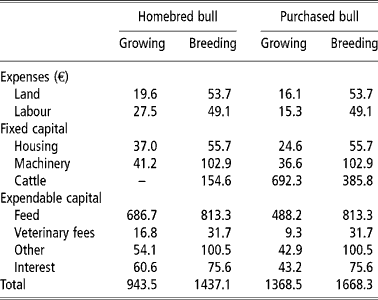
Total annual expenses during the breeding period were calculated to be € 1440 ($1820) and €1670 ($2110) for the homebred and the purchased bull, respectively. These figures include growing phase costs and culled bull income. The difference is attributed solely to higher fixed capital expenses for the purchased bull (depreciation plus interest). When this extra cost is not taken into account, feed expenses represent about 63 to 64% of the total for both bulls.
The cost per pregnancy from NS bulls ranged from €144 to €167 ($182 to $211) for 10 pregnancies to €18 to €21 ($23 to $26.5) when bulls were fully used (80 pregnancies), for homebred and purchased bulls, respectively (Figure 1).
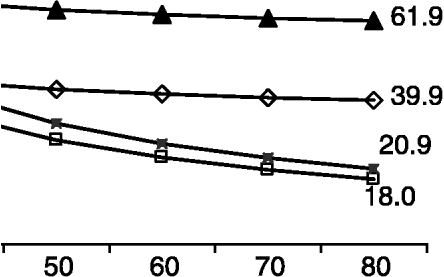
Figure 1 Natural service and artificial insemination costs per pregnancy; homebred bull (□), purchased bull (■), AI semen price 15(◇) and 25 (▲) euros per straw.
The average cost per pregnancy associated with DIY-AI ranged from €75 to €97 ($95 to $123) (Figure 1) for 10 pregnancies to €40 to €62 ($51 to $78) for 80 pregnancies, depending on semen price (15 and 25 Euros per straw, respectively). With 80 pregnancies, semen cost represented 83% and 89% of the direct AI cost, respectively, while it was only 44% and 57% of the total when only 10 pregnancies materialised (Figure 2). Under these circumstances, direct AI costs turned out to be higher than NS on farms with more than 20 to 25 or 30 to 35 cows, when semen was priced at €25 or €15 ($32 or $19) per straw, respectively (Figure 1). Direct cost of AI daughters was between €38 and €88 ($48 and $111.2), higher than their NS counterparts depending on feed and milk prices. This means the AI daughters have to produce between 125 and 350 kg of milk per lactation more than the NS counterparts in order to cover this extra direct cost.

Figure 2 Proportion of direct AI cost accounted for by semen price; AI semen price 15 (◇) and 25 euros per straw (▲).
Indirect costs due to extended calving intervals
Mean costs resulting from ECI (indirect AI costs) ranged from €2.9 ($3.7) per day when the calving interval was 380 days, (100 days open), to €8.6 ($11) per day when the calving interval was 455 days (175 days open) (Figure 3). When AI results in ECI, the costs associated with ECI must be added to those from the direct comparison of AI and NS. This increases the amount of the additional milk that AI daughters must produce.
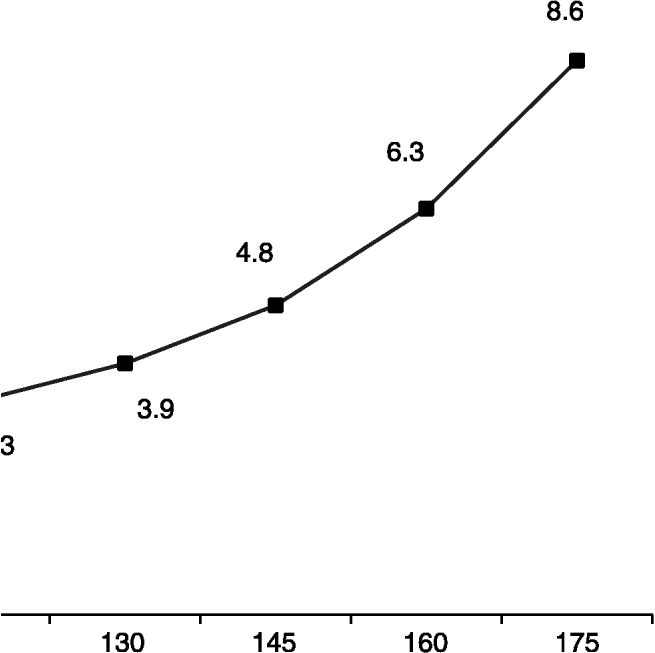
Figure 3 Average cost of extended calving interval as a consequence of prolonged days open.
All factors examined had a significant effect on the amount of milk needed to cover total extra AI costs (Table 4), with number of days open having the largest effect. Number of days in milk when open cows were no longer bred (a management decision), ranked second, closely followed by peak milk yield. Interestingly, all other factors, although significant, had a relatively small effect.
Table 4 Factors affecting the amount of additional milk required by AI daughters to recover the extra cost of using AI and corresponding adjusted Wald statistic (F); all factors were statistically significant (P<0.05)
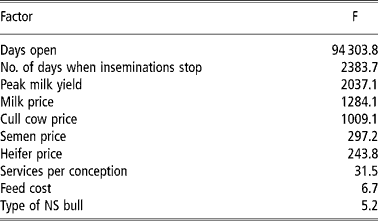
Semen price, number of services per pregnancy and type of NS bull (homebred or purchased) together constituted the costs associated with the service method of choice (AI or NS). The extra cost associated with the service method per se (direct AI costs – direct NS costs) accounted, on average, for only 11% of the total breeding cost. Such costs ranged from 2% to 29% (Figure 4), depending on calving interval. Costs associated with ECI, as a consequence of prolonged days open, constituted the major proportion of the extra costs of using AI.
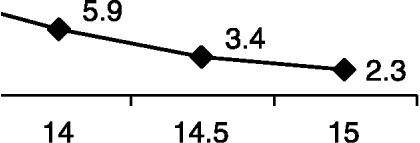
Figure 4 Proportion of total breeding-associated costs accounted for by the service method of choice depending on calving interval.
Amount of additional milk needed to cover the extra costs
The average amount of additional milk needed from AI daughters to cover total extra costs of using AI for various calving intervals, together with the 95% confidence interval, is shown in Figure 5. When the real calving intervals were considered (13.0 and 13.7 months for NS and AI, respectively), the additional milk needed per lactation in order to cover the extra costs of using AI was 441 kg.
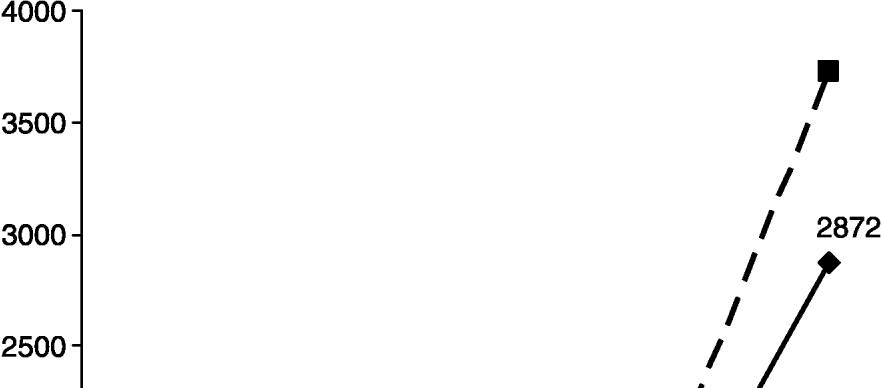
Figure 5 Average (middle solid line) and 95% confidence interval (upper and lower dotted lines) of the amount of additional lactation milk yield required by AI daughters to recover the extra cost of using AI, depending on their calving interval; actual superiority of AI daughters observed in Greece (♦) and the USA (●); NS calving interval was assumed to be 12 months.
As NS bulls were assumed to achieve 12-month calving intervals, a difference of more than 1,100 kg of milk per lactation was needed to cover the extra costs when AI calving intervals were longer than 14 months. However, about 700 kg were enough when the AI calving interval was 13.5 months (410 days).
In our data, cows sired by proven AI semen produced an average of 896 kg of milk per year more than daughters of NS bulls (Table 1). When calving intervals were kept within reasonable limits, AI was more profitable than NS.
Discussion
Farmers often complain about the escalating cost of production. However, most of them underestimate or even ignore the cost of keeping NS bulls on their farms. Even if they consider relevant expenses for labour, housing, machinery and supplies as small, still ¾ of the total expenses of keeping NS bulls is due to feed and depreciation (Valergakis, Reference Valergakis2000).
One of the reasons for the rapid expansion of AI in the past was its lower cost compared with NS in small farms. This is still true but nowadays there are not many small farms left. Nevertheless, when the bull to cow ratio is close to 1:40 (i.e. 40 pregnancies are expected per bull) direct AI and NS costs are similar when semen prices are €11 to €13.6 ($14 to $17) per straw. This holds true either for small farms ( < 40 cows) using a single NS bull, or bigger farms using more than one NS bulls, or, primarily, for farms that use clean-up bulls (31% of the farms in this study). Cows requiring four or more inseminations to conceive should be less than 15% of the herd (Archbald, Reference Archbald and Howard1993). If a clean-up bull is used for 20% of the cows in the herd then, for semen priced at €15 or €25 ($19 or $32) per straw, AI becomes less expensive than keeping an NS clean-up bull in herds with less than 150 or 100 cows, respectively. Most Greek farms are smaller than this. If cheaper semen, either from Holstein or other dairy or beef breed bulls is used for those ‘low fertility’ cows, AI can become even more competitive in farms that use clean-up bulls.
The present study considered only an AI scenario where farmers themselves administer semen to their cows. This is the current trend in the country gradually replacing the previous system where inseminators were state employees. Commercial AI is still in its infancy in Greece and although it seems profitable for very small herds, its profitability is questionable in medium sized farms (70 to 200 cows), when dairy managers have the time to personally assume the task. The ‘do-it-yourself’ option is therefore considered the most suitable under Greek conditions.
Artificial insemination is more expensive for farms that make good use of NS bulls (80 pregnancies per year). The difference between homebred and purchased NS bull is small and if the latter results in less inbreeding and better herd genetics, it is certainly a worthy choice.
On farms where AI is more expensive than NS, the major part of the extra cost results from potentially extended calving intervals (a consequence of increased number of days open). Large-scale surveys confirm this assumption, reporting calving intervals of 13.0 v. 13.7 (Valergakis, Reference Valergakis2000), 13.8 v. 14.1 (Zwald, Reference Zwald2003) and 13.6 v. 14.1 months (Smith et al., Reference Smith, Ely, Gilson and Graves2003) for NS and AI, respectively. Others, however, report equal or superior performance of AI (Williamson et al., Reference Williamson, Morris and Anderson1978; Shaw and Dobson, Reference Shaw and Dobson1996; Niles and Risco, Reference Niles and Risco2002; Overton and Sischo, Reference Overton and Sischo2005), suggesting that calving interval is not a matter of service method per se but mostly a management issue. When using AI and the effective pregnancy rate is more than 25%, the use of NS bulls does not improve net income per cow significantly (Risco, Reference Risco and Chenoweth2000). In any case, the common belief in Greece that NS bulls generally achieve 12-month calving intervals proves to be a myth (Valergakis, Reference Valergakis2000). Moreover, when NS bulls achieve shorter calving intervals than AI, the difference tends to be less than 1 month (Valergakis, Reference Valergakis2000; Smith et al., Reference Smith, Ely, Gilson and Graves2003; Zwald, Reference Zwald2003).
The cost of extra days open resulting from the method used (French and Nebel, Reference French and Nebel2003b) in this simulation, ranging from €2.9 to €8.6 ($3.7 to $10.9) (the mean cost per day open was €5.0 [$6.3]) is higher than those most recently calculated either by Plaizier et al. (Reference Plaizier, King, Dekkers and Lissemore1997) (Canadian $4.7 per day, €0.72 /Canadian $) or González-Recio et al. (Reference González-Recio, Pérez-Cabal and Alenda2004) (US $4.9 per day, $0.82/US $). It is even higher than that calculated by French and Nebel (Reference French and Nebel2003a) using the same method (about US $2.0 per day open). It seems that current market conditions in Greece have a greater impact on cost of days open than in Canada, Spain or the US, making extended calving intervals even less desirable and stressing the need for country- and time-specific calculations.
Number of days in milk when open cows are no longer inseminated, a decision closely related with the culling policy of the farm, was the factor with second largest effect on higher AI costs in this study. It is clear that farmers need to develop and follow a well thought-out plan on this issue.
Factors that usually attract the attention of dairy farmers (milk, cull cow, semen, heifer and feed prices) had a statistically significant but very small effect on the comparison between AI and NS costs in this study. Plaizier et al. (Reference Plaizier, King, Dekkers and Lissemore1997) found that milk, carcass, feed and replacement heifer prices did not significantly affect the cost of days open. These factors do not have to be considered as primary ones in the decision-making process concerning the choice of service method.
In the present study, daughters of proven AI sires were producing 896 kg more milk per cow per year than daughters of NS bulls. Norman et al. (Reference Norman, Powell, Wright and Slatter2002) and Cassell et al. (Reference Cassell, Jobst, McGilliard and Pearson2002) reported differences of the magnitude of 360 to more than 500 kg, respectively. Other researchers report considerably greater differences of 1221 (Zwald, Reference Zwald2003), 1464 (Smith et al., Reference Smith, Ely, Gilson and Graves2003) and 1333 (De Vries et al., Reference De Vries, Steenholdt and Risco2005) kg of milk, in favour of farms using AI exclusively (Figure 6). The higher overall milk production in US farms considered in the latter studies is most probably the source of the difference between them and the Greek dairy farms. Selection for milk production is additive by nature and will eventually have the same effect in Greece. The advantage of AI daughters over their NS counterparts is expected to increase in the future. Combined selection for milk production and fertility will provide AI an additional advantage. Only when the bulls used for NS are of the same genetic merit with those that are sampled for AI can the economic losses be reduced (Risco, Reference Risco and Chenoweth2000). Because of the size and complexity of most progeny-testing schemes currently catering to the international AI semen supply, this is not expected to ever be the case. Actually, NS breeding would first have to play catch up with AI, given the existing difference, before becoming competitive. Results from the present study further corroborate this assertion.

Figure 6 Milk production in farms using exclusively AI or NS.
Using the difference of 896 kg of milk between AI and NS farms calculated in this study and considering the least favourable scenario for AI (NS bulls achieving a 12-month calving interval), AI was always more profitable when the calving interval was 13 months or lower (Figure 5). Furthermore, AI was more profitable in 97% of the cases examined when the calving interval was 13.5 months (Figure 5). In the future, the difference between AI and NS farms in Greece is likely to follow the US pattern, that is, to average more than 1300 kg of milk in favour of AI farms (Smith et al., Reference Smith, Ely, Gilson and Graves2003; Zwald, Reference Zwald2003; De Vries et al., Reference De Vries, Steenholdt and Risco2005). When that happens, AI will be more profitable than NS in all herds with calving interval shorter than 14 months and even in 94% of the herds with a calving interval of 14 months (Figure 5). Under Greek conditions, the expected difference of 1000 to 1300 kg between AI and NS farms will result in 6 to 7% lower production costs and a 30 to 35% increase in profits (Valergakis and Banos, Reference Valergakis and Banos2004).
It appears that, under Greek conditions, when the difference in calving intervals between NS and AI farms is kept below 1.5 to 2.0 months, AI is the most profitable option. Better reproductive management will present even more benefits to dairy farmers that use AI.
It must be noted that, in all cases, none of the other benefits of AI or the potential problems of NS was given a monetary value in this study. The former includes selection for better conformation, increased milk components, lower somatic cell counts, improved fertility, longer productive life, and easy calving sires etc. All have a positive effect on dairy farming profitability (Esslemont et al., Reference Esslemont, Bailie and Cooper1985; Barth, Reference Barth, Braun and Youngquist1993; Ensminger, Reference Ensminger1993; Peters and Ball, Reference Peters and Ball1995; Vishwanah, Reference Vishwanah2003). On the contrary, NS means increased risk of venereal disease transmission, management problems with early-bred heifers and unknown drying-off and calving dates, increased frequency of dystocia, accidents during mating, possible low bull fertility or libido and bull morbidity/early culling, all negatively affecting profitability (Esslemont et al., Reference Esslemont, Bailie and Cooper1985; Barth, Reference Barth, Braun and Youngquist1993; Ensminger, Reference Ensminger1993; Peters and Ball, Reference Peters and Ball1995; Vishwanah, Reference Vishwanah2003). Moreover, farm personnel safety issues can never be over-emphasised.
Conclusion
Even under less than average management conditions, AI is more profitable than the best NS scenario. The efficient communication of this message should be a primary concern of the AI industry. The documented profitability of genetically superior cattle must be comprehensively presented to dairy farmers so that they can truly make informed decisions. The Greek dairy industry can have a considerable benefit from lower production costs and increased profits.












